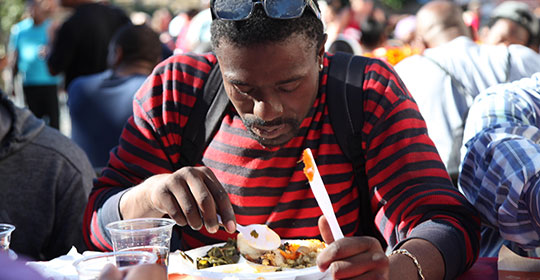
When College Students Can’t Come Home for Thanksgiving
November: It’s a time to give thanks, and for many, it’s a time to come home for Thanksgiving. For college students, it often marks their first trip back since the semester began. But for up to 58,000 students who identify as “homeless” on the Free Application for Federal Student Aid,” there is no home to come home to.
It’s something many people don’t think about. Homelessness is typically associated with older adults who have addiction or mental health issues, or who have fallen on hard economic times. While those circumstances are often the case, homelessness also can affect students, who are going to school to get an education and ultimately be able to earn a living.
Student homelessness can be the result of parents no longer being able to provide support, or a lack of affordable student housing. Some students have housing while the dorms are open, but have nowhere to go when school is not in session. For some students, family dynamics of violence, mental health issues, addiction, and conflict can make the possibility of going home impossible. Regardless of the reasons, the number of homeless college students is up 75% over the last three years, and that number – one source indicates – is likely an underestimate.
To address this issue on a local level, the Los Angeles Mission has begun to work with Southwest Community College in South Central L.A. and LA City College to address the housing and service needs of students during holiday breaks and year-round. As in much of L.A., there is little affordable housing surrounding these schools. Good jobs are needed in order to make rent or a mortgage. But good jobs require a good education, and thus these kids are in a Catch-22.
As one of the country’s leading non-profit organizations serving the homeless, the Los Angeles Mission extends its reach beyond Skid Row and delivers resources wherever they’re needed, even college campuses. To serve the students of Southwest Community College and LA City College, this means providing basic supplies and emergency assistance to the homeless outreach programs. The Mission is also developing a pilot program for housing students until permanent housing is found.
The Mission asserts that nothing helps reduce the chances of homelessness like education. And sleeping in tents or navigating shelters is not the answer.
Moreover, the Los Angeles Mission provides hope – an inspiration for students that as they’re going through a process that’s challenging even with homes and support systems, their hard work will ultimately pay off.
This outreach with the colleges shows that fighting homelessness demands more than a one-size-fits-all solution. Sometimes it means giving a mentally ill person shelter for the night. But sometimes, it means reaching a college kid who can’t come home for Thanksgiving by letting them know somebody cares.
Either way, just as in business, success calls for agile, responsive approaches: Anticipating needs and thinking outside of the box. Whether you’re addressing homelessness, or taking a company to the next level, it’s about exploring where the needs are, and creating opportunities to make a big change for people and for society.

